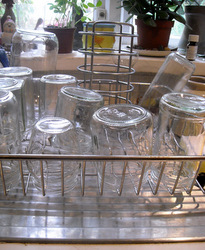How to remove glue from jam jar labels
Posted by Fiona Nevile in Discoveries, Reviews | 28 commentsWhy is it always the prettiest jam jars that have the most stubborn labels and glue? There’s no chance that they would accidentally peel off and nobody would know what was inside. And when you want to fill them with your own home made preserves they cling to their gluey deposits like stubborn stains.
I’m late with my Seville orange marmalade making this year. But I have Sevilles, lemons and sugar at the ready. The real problem has been the jars. In past years I have washed them, dealt with the labels and stored them ready for use. Unfortunately last year I just washed them, put them in carrier bags and slung them in the barn.
My first problem was actually locating the jars. After a long search I discovered twelve labelled jars in a carrier bag. Soaking things in clothes washing powder or liquid has been an answer to many of my kitchen woes in the past and I thought that I’d give this a whirl with the jars. It worked a treat, computer generated labels came off and their glue was washed off easily!
However, I had nine jars with thick labels and gunky glue. The thick labels came off relatively easily but the glue was holding on tight.
Then I remembered a comment that Pat had left a comment back in August 2010 on the blog.
“To remove the sticky residue on any container after the removal of the previous label you should use ….WD40,
It claimed its use on the tin and with enough on a paper towel it makes short work of that mess I assure you !!!
Give it a go, but remember to replace the one you take from the tool box because after you see what it can be used for you won’t put it back !!”
Clearly I had used our can of WD40 for something else and had not put it back, as it wasn’t in the tool shed. So I valiantly tried groundnut oil, cigarette lighter fuel – they were about 3% efficient. Then in frustration and despair turned out the cleaning cupboard under the sink.
I found the WD40 lurking in the murky depths! One quick spray and the glue just wiped off. Our can of WD40 will now be living permanently under the kitchen sink, having just read this extensive list of the uses of WD40 I can see how invaluable it’s going to be in the future.
Leave a reply






My word. It worked, thank you.
At the time I did’nt have any WD40 so I used Lighter fuel worked great got rid of that horrible stubborn glue, bought it from the £1 shop
Orange oil-sold for furniture polish-works on many labels and it smells a lot better than the WD-40. A few, though, seemed to be on with some kind of hotglue that laughed at it. Even a razor blade just smeared it around. Finally, I let it cool-it gets stickier when hot-and then stuck a strip of duct tape on it, then slowly peeled it off-sometimes it takes a few ‘peels’ but the adhesive sticks to the tape harder than the jar and peels off.
I use white spirit. Works a treat but it’s really smelly and you have to be careful to remember to run the jars throught the dishawasher afterwards.
Wow and I only use WD40 for squeaks and rusty screws. If you don’t have any handy though supermarket cheapest polish gets off the worst sticky labels but it does require a few minutes light rubbing. Thank you for the useful tip on WD40 though I’ll definitely look up that long list. I like the limescale one from Sandra
Fiona, I can confirm Pamela’s report on the Lakeland product ‘sticky stuff remover’ as a quick and easy remedy to remove labels of all sorts!
Hurrah for WD40. Thanks for this tip. And according to my hubby it also removes limescale deposit from sink taps. (Is that on the long list above?)
Once again the timing of your post astounds me! Last night I took the hob scaper to some jars that had had a full 24hr soak but refused to yield their glue. Good for all but one, whereupon the hob scraper bit me on the side of the thumb! I’ll definitely be trying the WD for the most stubborn ones in future, thanks for the tip!
Well, there you go. I was reading the top of your post, and thought, “must mention WD40” and then I scrolled down.
We used to use it in the bookshop, when the wholesalers had sent us books with the glue from Waterstones ‘3for2’ labels still on the covers. We had to spray it onto paper tissues and wipe carefully, but the laminating on modern paperbacks could take it.
Dani, the cooking oil is one of many solutions I have tried, and I can tell you it won’t work on Geeta labels! In my experience, even if it gets rid of the label, it doesn’t necessarily get rid of the glue.
The dishwasher is good for getting rid of less tenacious labels, providing you take the jars out while they are still hot and pull off any remaining bits of label. But again there’s quite often glue left behind.
Sigh. In my youth, you simply put jars in a sink of very hot water, and labels and glue floated off.